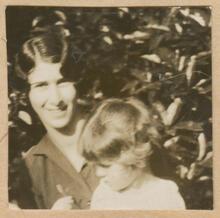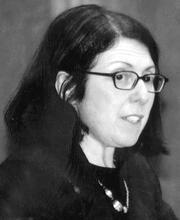Mimi Pinzón
Mimi Pinzón was the pseudonym chosen by Adela Weinstein-Shliapochnik. Pinzón immigrated to Buenos Aires at the age of four with her family and attended Argentinean public schools while also receiving instruction in Yiddish in evening schools and private lessons. In 1965, she published her most famous work Der hoyf on fenster, which follows the story of a girl living in the conventillos of Buenos Aires. Along with this novel, Pinzón contributed to numerous Yiddish and Spanish periodicals, as well as teaching in Buenos Aires Yiddish institutions. Pinzón has been praised for her ease of passage between languages, and she is arguably the sole significant Yiddish writer who spent none of her school years in Eastern Europe.
Early Life and Education
Mimi Pinzón—cf. Mimi Pinson, a Parisian seamstress in French Romantic Alfred de Musset’s story by the same name—was the pseudonym chosen by Adela Weinstein-Shliapochnik (b. 1910 Belotserkov, near Kiev; d. 1975 Buenos Aires). She arrived in the Argentinean capital with her parents at the age of four. The family lived in the Buenos Aires equivalent of the New York tenements—the so-called conventillos, with other Jews as well as recently arrived Italians and Galician Spaniards.
Mimi Pinzón is arguably the sole significant Yiddish writer who spent none of her school years in Eastern Europe. She went to Argentinean public schools, but also received instruction in Yiddish in evening schools and private lessons. One of her teachers was the poet Moyshe Pintshevski (1894–1955), who would return to Europe and die in a Soviet camp.
Mimi Pinzón’s literary imagination remained full of memories of the conventillos and even earlier ones of her native Belotserkov, called colloquially in Yiddish Shvarts-Tume—“Black Impurity.” The editors of the local Yiddish paper Di Prese, who published her first stories when she was sixteen years old, originally refused to believe that an adolescent raised in a Spanish-speaking environment could master Yiddish style so well.
Der hoyf on fenster
In 1965 Pinzón published one of the most interesting childhood novels ever to have appeared in Yiddish, Der hoyf on fenster (The Courtyard Without Windows, 1965). The author of the article on Pinzón in the Biographical Dictionary of Modern Yiddish Literature, Y. M. Briderman, places the protagonist Etl—modeled on Pinzón in her early years—on a par with Sholem Aleichem’s Motl Peysi and David Bergelson’s Penek. Briderman notes that the very names Etl and Motl sound alike, but that Pinzón had the merit of adding a girl to the pantheon of Yiddish literary heroes.
Rather than recalling Sholem Aleichem (1859–1916) or David Bergelson (1884–1952), the English-language reader might think first of a different parallel to Pinzón’s Etl: the boy in Henry Roth’s Call It Sleep. Pinzón’s writing shares with Roth’s a somewhat oneiric, disquieting glimpse into the immigrant child’s elaboration of reality in his or her new land. We see this when Pinzón’s Etl (translated here as Ethel) ponders how people live beyond the wall separating her family’s miserable rooms in a conventillo from the neighboring bourgeois apartment house complete with an elevator:
The wall was so remote and foreign to the people living on the courtyard that it became for them something nearly legendary, nonexistent. Or if it existed, it did so as something far, far beyond them, both in terms of the space they inhabited and their grasp of the world. Irritated mothers would threaten children who refused to go to sleep: “Just wait. They’ll come and get you from beyond the wall, throw you into a sack, carry you up to the top floor, and do to you there who knows what!” When the women fought over a place at the courtyard sink or over a bit of clothesline on which to hang their laundry, they would take aim at a pushy neighbor or a new tenant with these venomous words: “If Madame finds it cramped here, why doesn’t she tell her husband to rent an apartment beyond the wall?”
Ethel was aware of how people beyond the wall lived. Each family had its own apartment, with two, three, or even more rooms: separate rooms to eat in and to sleep in. She knew that each family had its own kitchen, with four brick walls, a ceiling, a sink and a stove with burners. She knew that each family had its own bathroom, with a bathtub and white limestone walls. Ethel knew all of these things, in the way one knows there is someone who rules the land. No one has ever seen him, no one has ever spoken to him, but one is sure he exists. (Der hoyf on fenster [“The Courtyard Without Windows: Excerpt from a Novel,” p. 60]).
Other Literary Works
One of Pinzón’s greatest accomplishments in this novel consists in rendering into a believable Yiddish the comments—necessarily in Spanish—of Etl’s public school teachers and of her family’s Christian neighbors. Pinzón’s ease of passage from one language to another reappears in her translations from Yiddish into Spanish and vice versa. She put into mame-loshn works by the great Argentinean writer Jorge Luis Borges, the Argentinean poet Alfonsina Storni and the Uruguayan novelist Horacio Quiroga. Surely more important, nowadays, than those linguistic tours de force are Pinzón’s collection in Spanish of Soviet Yiddish writers, La sangre de tu hermano Abel (The Blood of Thy Brother Abel, 1945); or Los acusados (The Accused, 1947), her translations of writings by José (Yoysef) Rabinovich (1903–1977), a “crossover” phenomenon in Argentinean Jewish letters, a poet and storyteller who started his career in Yiddish and ended it in Spanish.
Writing also under the pseudonyms Ad-Sum and Yidl Kotoynti, as well as her true name Adela Shliapochnik, Mimi Pinzón collaborated on numerous Yiddish periodicals in Buenos Aires and elsewhere, including: Di prese, Di folksshtime, Haynt, Der veg, Ikuf, Afsnay, Nayvelt, Nay lebn, Kinder-tribune, Undzer fraynd, Undzer lebn, In gang and Di yidishe froy. She also worked on the Spanish-language periodicals Judaica and Renovación, as well as teaching in Buenos Aires Yiddish institutions such as the Y. L. Peretz School and the Haim Zhitlovsky School.
Personal Life
Pinzón’s husband, Isaac Shliapochnik, born in 1905 in Yaneve (Janova, 32 km NE of Kaunas, Lithuania, near the Vilye river), also wrote for Buenos Aires Yiddish newspapers, sometimes under the pseudonym Izi Shafer. The couple met in the editorial offices of Di prese and married in the Argentinean capital on September 21, 1929. They had two children: a son, who is now a neurologist; and a daughter, a physical therapist in the United States. Shliapochnik/Shafer is currently honorary director of the Buenos Aires branch of the YIVO Institute for Jewish Studies.
Pinzón passed away in Buenos Aires on December 10, 1975.
Briderman, I. M. “Pinzón, Mimi.” Leksikon fun der nayer yidisher literatur. Vol. 7 (1978), col. 129–131.
Pinzón, Mimi. Der hoyf on fenster. Buenos Aires: 1965.
Idem. “The Courtyard Without Windows: An Excerpt from a Novel.” Translated by Alan Astro. In Yiddish South of the Border: An Anthology of Latin American Yiddish Writing, edited by Alan Astro, 59–66. Albuquerque, New Mexico: 2003.
Shliapochnik, Adela, trans. Los acusados by José Rabinovich. Buenos Aires: 1947.
Idem, trans. La sangre de tu hermano Abel: Relatos soviéticos by David Bergelson et al. Buenos Aires: 1945.













